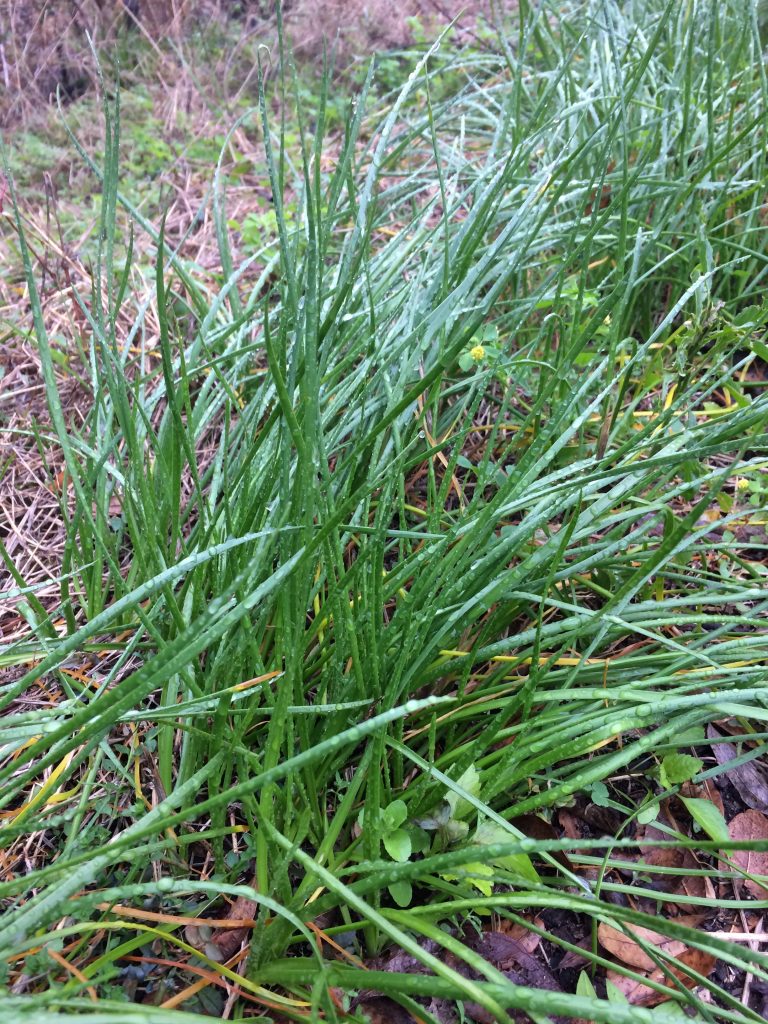
Going north to forage is pleasant this time of the year because it’s like going back in time a few weeks to find some favored plants still producing. Goosegrass, which I have not seen for a while in the central part of the state was very alive and happy in Gainesville this past Saturday. Chickweed was still abundant there as was Pellitory. We found one example of Sheep’s Sorrel. A nice find was Wild Allium still not old enough to put on cloves. Some call it an onion others call it a garlic. To read about it go here.
Black Cherry vs Laurel Cherry: This is a good time to highlight the differences between wild Black Cherry and wild Cherry Laurel, both native. That latter not only has fruit on it now but is also blossoming. The fruit of the Black Cherry (Prunus serotina) is edible when ripe. The fruit of the Cherry Laurel (Prunus caroliniana) is always toxic. A quick look at the leaves can tell them apart. The Black Cherry has consistently small teeth around the entire edge of the leaf. And if you look at the backside of the leaf the main stem near the base will have hair on both sides for about an inch. The hair starts out whitish but will change to light tan and then dark brown as the season progresses. The soft Black Cherry fruit is dark red to purple with a dimple in the end.
The Cherry Laurel leaf is quite different. It’s teeth are sporadic, especially on older trees or older leaves can have no teeth at all. Younger leaves can have many teeth but they are not consistent or well-organized. Also the back of the Cherry Laurel leaf does not have any hair along the stem. Instead it often has two red-gray-green dots near the base. They can be faint but each leaf will have those dots, which are really glands. They also are not in the exact same spot all the time. Very young leaves can have red spots, then gray or they can fade greatly. Cherry Laurel leaves also smell of almonds or maraschino cherries when crushed which is cyanide (assuming you are among those who can smell cyanide. Many people cannot.) The hard fruit of the Cherry Laurel is dark blue to black and pointed. NOT EDIBLE. Besides the fruit the leaves are toxic to most mammals.
Although it may sound odd the Black Cherry tree also looks like more like a typical cherry with its bark being more checkered than the Cherry Laurel. I have read there are Pin or Red Cherries growing in Florida but the only edible one I’ve ever see here is the Black Cherry. I grew up in Maine where we harvested choke cherries to make jelly and wine. The read more about the Black Cherry go here.
This week’s arguable question is “can you eat elderberries raw?” I call it “arguable” because no matter whether I say yes or no someone will email me and tell me I’m wrong. My answer is “yes and no” which means I will irritate both sides. There are a few variables but it’s fairly easy to sort out.
First, elderberries contain two kinds of toxins, an alkaloid, and, cyanide-producing glucosides. The alkaloid is present in unripe berries. It is not a problem in ripe berries but ripe berries still have cyanide-producing glucosides. This discussion is only about ripe elderberries. If we are referring to dark purple elderberries, such as Sambucus canadensis or Sambucus Mexicana, the answer is yes, you can eat a few raw if you are an adult, very few if you are a child. If we are talking about red elderberries (Sambucus pubens and Sambucus racemosa for example) the answer is definitely no regardless of your size. You can only eat the cooked pulp of red elderberries and then no seeds. Red elderberries were a staple of some Indians but only after much processing.
In shirt-sleeve language the cyanide-producing glucosides is usually sugar and cyanide bonded together which break apart on digestion producing a small amount of hydrocyanic acid aka prussic acid… cyanide. Your body can tolerate some cyanide. Thus eating raw ripe berries becomes a function of how many of these molecules there are, how much you ate of them, how large are you and how much water there is in your digestive system which probably relates to how quickly you digest them which means how quickly is that cyanide release. A few raw ripe berries usually does not bother an adult any more than eating half-a-dozen apple seed. More than a few ripe purple elderberries can make a child ill usually with digestive upset and vomiting. Same with an adult but it takes a few more berries. Raw elderberries are well known to cause nausea. Cooking (or drying) ripe purple elderberries eliminates the problem completely. I’ve eaten a tablespoon of raw ripe purple elderberries at a time and not been bothered. But I know of many adults who have eaten a handful and gotten sick, not death-door ill but sick nonetheless. The amount of toxicity is considered mild which means little when you’re feeling lousy.
Ripe Red Elderberries are different than purple ones. They have much more potential cyanide material in their seeds and cooking does not get rid of that problem completely. That is why Native Americans ate only cooked Red Elderberries with the seeds removed, a labor-intensive process. Said another way red elderberry seeds cannot be eaten raw or cooked but red elderberry pulp can be eaten after cooking, and even that is debatable. When the natives ate too many Red Elderberry seeds their antidote (and I don’t know if it worked or not) was to drink lots of water and consume salmon oil.
So the answer is yes you can eat some ripe, raw purple elderberries but no you should not eat a lot, if only to be safe. Personally I think ripe dark purple elderberries taste far better dried or cooked than raw. Drying or cooking drives off a musty flavor they tend to have and improves the flavor.
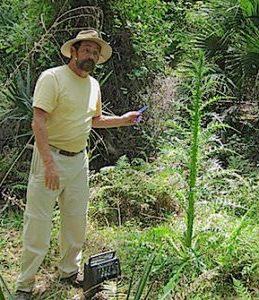
Foraging Classes: Saturday’s class this week is in Sarasota, always a pleasant park to visit. Sunday’s class is a little different: It is in downtown Winter Park. There are plenty of plants to see and also introduces foraging in a small city environment… and there are a couple of coffee shops along the way.
Saturday, February 9th, Red Bug Slough Preserve, 5200 Beneva Road, Sarasota, FL, 34233. 9 a.m. to noon.
Sunday, February 10th, 329 N. Park Avenue, Winter Park, FL. 9 a.m. to noon. Meet in front of Panera’s. Parking is free in the parking garage behind Panera’s.
Saturday, February 16th, Jervey Gantt Recreation Complex, 2390 SE 36th Ave., Ocala, FL, 34471. 9 a.m. to noon. Meet at the entrance to the pool, aka Aquatic Fun Center.
Sunday, February 17th, Bayshore Live Oak Park, Bayshore Drive. Port Charlotte. 9 a.m. to noon. Meet at the parking lot at the intersection of Bayshore Road and Ganyard Street.
Saturday, March 2nd, Blanchard Park, 10501 Jay Blanchard Trail, Orlando, FL 32817. Meet near the tennis court near the YMCA building. 9 a.m. to noon
Sunday, March 3rd, George LeStrange Preserve, 4911 Ralls Road, Fort Pierce, FL, 34981. 9 a.m. to noon. The preserve has no official bathroom or drinking water so take advantage of the various eateries and gas stations before arrival.
Saturday, March 9th, Florida State College, south campus, 11901 Beach Blvd., Jacksonville, 32246. 9 a.m. to noon. We will meet at building “D” next to the administration parking lot.
Sunday, March 10th, Haulover Canal, Merritt Island National Refuge, north of the Kennedy Space Center, 9 a.m. to noon or later. Because of its shape this class requires the most walking and climbing, about four miles’ worth. We meet at the end of the northwest jetty where they also launch kayak tours and have thoughtfully left Port-o-Lets. Also take into consideration that the time changes that weekend so don’t be late.
Let’s start this out with a fact: Seven billion gallons of water are used every day to water lawns and outdoor plants in the United States. Every day, seven billion galllons. Now read about Burton Knight, who has a degree in horticulture and lives in the Junius Heights Historic District of Dallas, Texas. As you probably know that area is vulnerable to drought. Water is often in short supply. With that in mind Knight removed the sod from in front of his house and installed xeriscaping including rocks, low-water plants and cacti: Native and very Texas. A local commission that watches over “historic districts” ordered him to tear it all out. Why? The cactus, the commission said, are not “historically appropriate.” The commission demanded Knight put back the non-native grass, in other words, a lawn.
According to the Dallas Morning News: For Knight rising water needs and a hotter, drier Texas as a result of global warming make up the state’s most urgent environmental crisis. He said his case suggests that the cultural norms that earned Dallas a reputation as a water hog are still deeply entrenched. “How can you say the cactus is not historic”? asked Knight, whose degree is from Texas A&M university. “Guess what crop has the greatest consumption of time, energy, water and chemicals? Turf grass.”
Columnist Jacquilynn Floyd pointed out how selective the preservationists are: “Living in a historic district shouldn’t be- can’t be- like living in a museum. Wood stoves and ice wagons are historically accurate, too, but they don’t really meet modern requirements…. a neighborhood can aged with grace and still evolve to adapt to a changing environment.”
It is interesting that the water-saving native plants in Knight’s front yard are unacceptable in the historic district but the car in the yard is acceptable. Why isn’t the commission also calling for the elimination of cars and demanding folks use the more historically correct horse for transportation?
While most municipalities still operate under the mentality that “Grass is God” some are changing. In Glendale, Arizona, just northwest of Phoenix, residents can earn $150 to $750 depending upon how much grass they remove from their lawn. And here’s a fact you can use: You can cut the water needs of your yard up to 50 percent by decreasing the grass to 40% of the total space and increasing trees to 60% of the total space. If you have the typical-size lawn that still leaves 2500 square feet to mow, or for the kids to play on… or teather a milk-producing goat… A few years ago I wrote and recorded an editorial for National Public Radio Holland about lawns and trees. I recently made it into a video you can watch here.
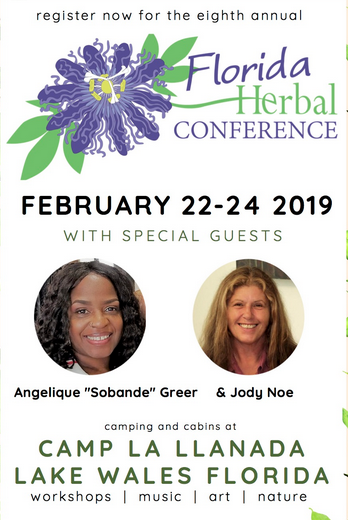
The Florida Herbal Conference is February 22-24. It’s their eighth annual event and for the eighth year I will be teaching there. You can learn quickly at conferences because you are getting a distillation of information from teachers with years of experience. Any questions can be answered quickly and to the point, no rummaging around to resolve an issue. You’re also with like-minded folks so there’s instant camaraderie. You are the majority. For more information go to: Florida Herbal Conference.

Donations to upgrade EatTheWeeds.com have gone well. Thank you to all who have contributed to either via the Go Fund Me link, the PayPal donation link or by writing to Green Deane POB 941793 Maitland FL, 32794. There are many needs left such as expanding the foraging teacher page and the page on monotypic edibles. I’m still having a hard time finding articles I wrote! There’s always something and such things get more complex and expensive every year. Indeed, the average email cost to send each newsletter is $20.

Want to identify a plant? Looking for a foraging reference? Do you have a UFO, an Unidentified Flowering Object you want identified? On the Green Deane Forum we chat about foraging all year. And it’s not just about warm-weather plants or just North American flora. Many nations around the world share common weeds so there’s a lot to talk about. There’s also more than weeds. The reference section has information for foraging around the world. There are also articles on food preservation, and forgotten skills from making bows to fermenting food. One special section is “From the Frightening Mail Bag” where we learn from people who eat first then ask questions later. You can join the forum by clicking on “forum” in the menu.

All My Videos are available for free on You Tube. They do have ads on them so every time you watch a Green Deane video I get a quarter of one cent. Four views, one cent. Not exactly a large money-maker but it helps pays for this newsletter. If you want to see the videos without ads and some in slightly better quality you can order the DVD set. It is nine DVDs with 15 videos on each for a total of 135 videos. Many people want their own copy of the videos or they have a slow service and its easier to order then to watch them on-line. The DVDs make a good gift for that forager you know especially on long, cold winter months. Individual DVDs can also be ordered or you can pick and choose. You can order them by clicking on the button on the top right hand side of this page (if your window is open wide enough.) Or you can go here.
If you would like to donate to Eat The Weeds please click here. Or you can use my Go Fund Me link, or by writing to Green Deane POB 941793 Maitland FL, 32794
This is weekly issue 341.

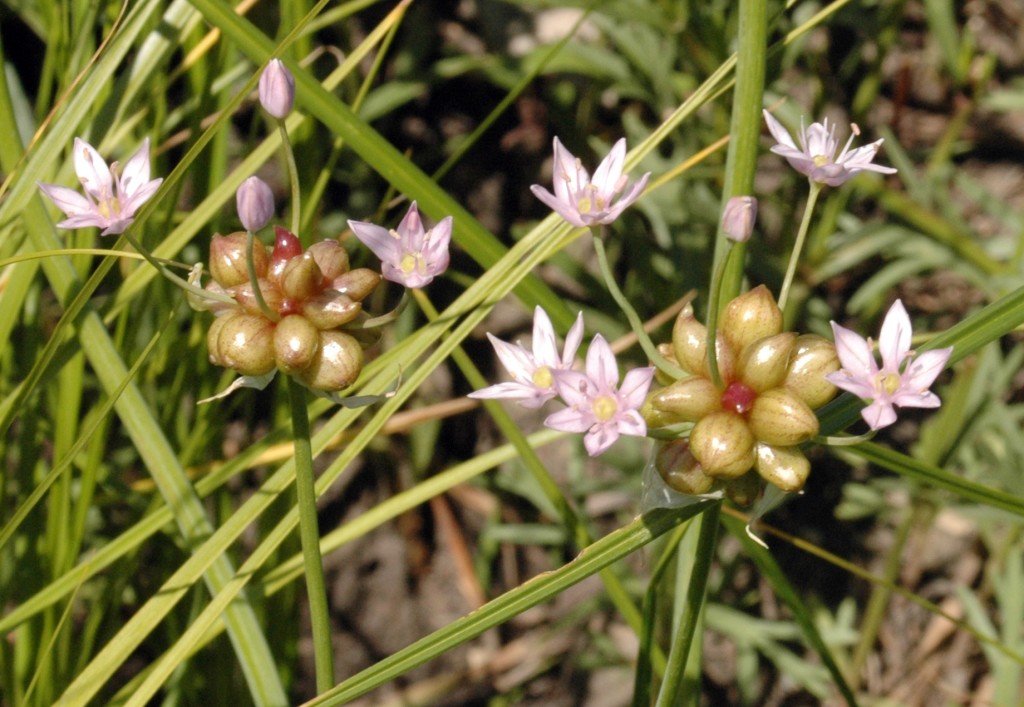
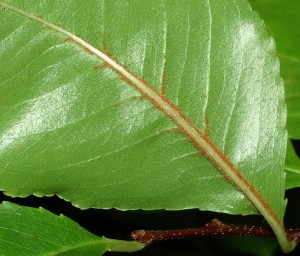
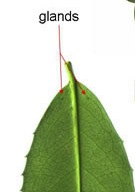
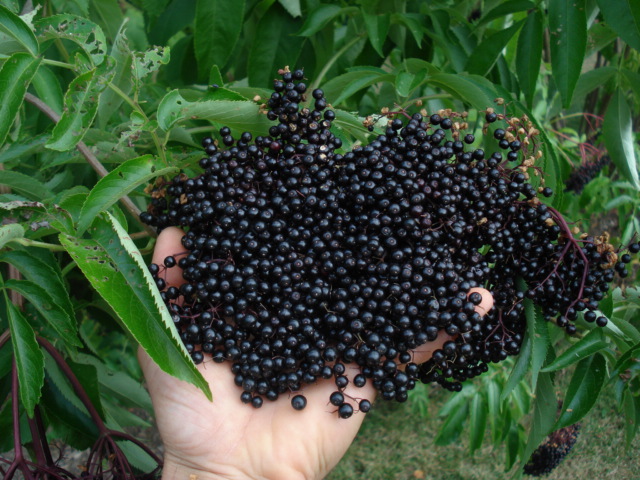
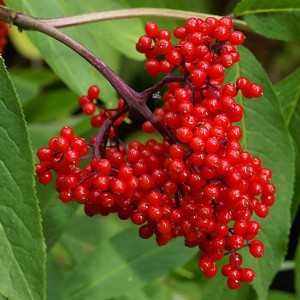
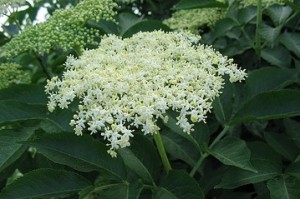

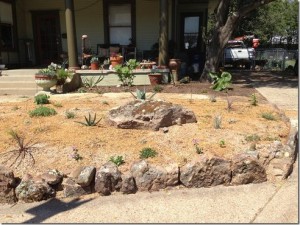


Hi Dean. Ive been trying to live a whole foods diet life, I am trying to find new flavors to add to my limited range of flavors. Are there many great tasting wild edibles I can add to recipes to have a better range of flavors.
Looking forward to the next local class.